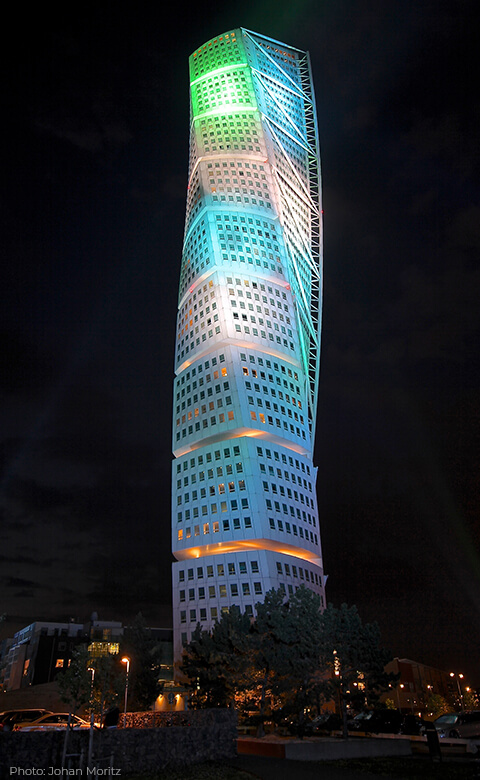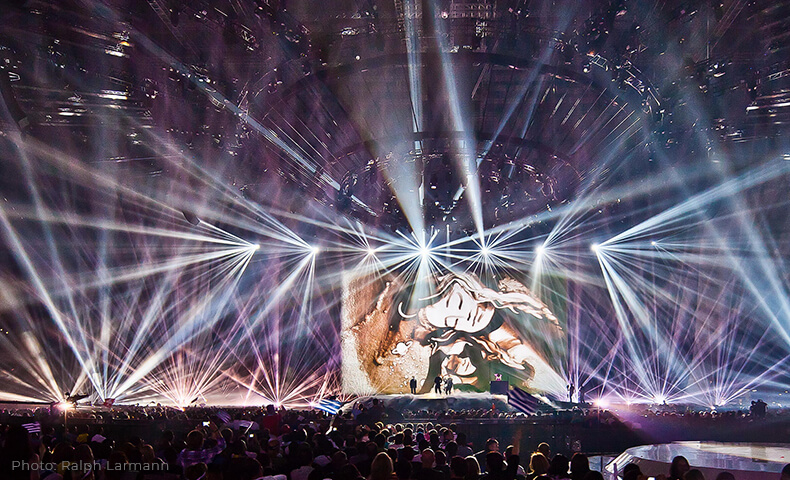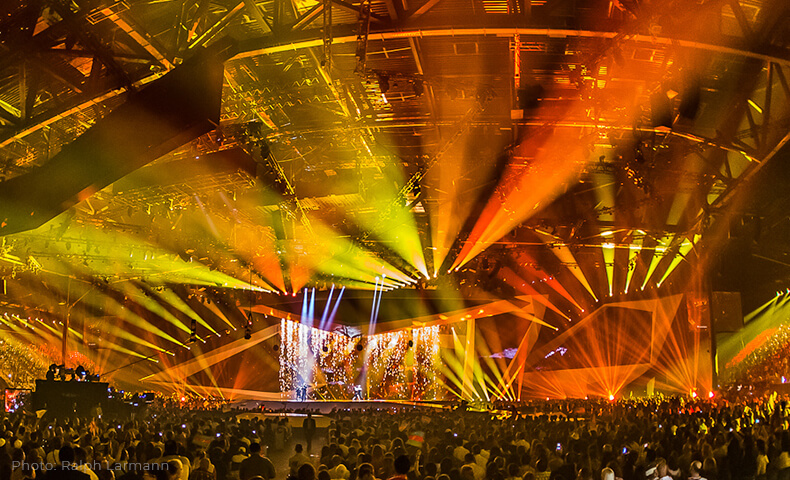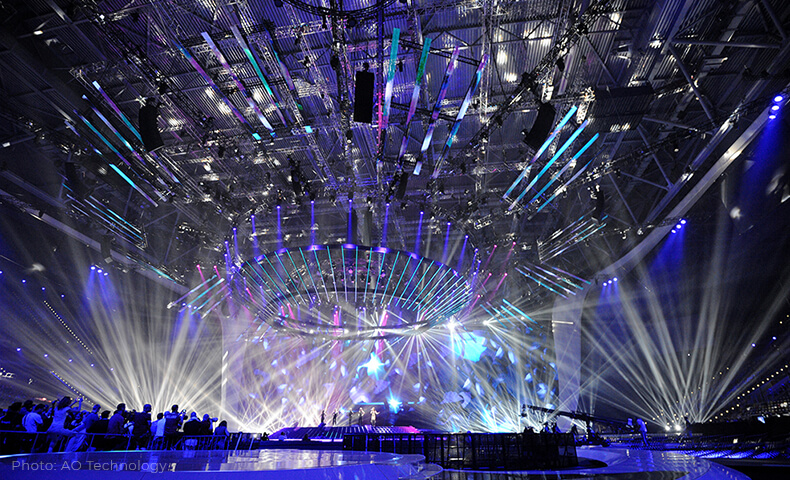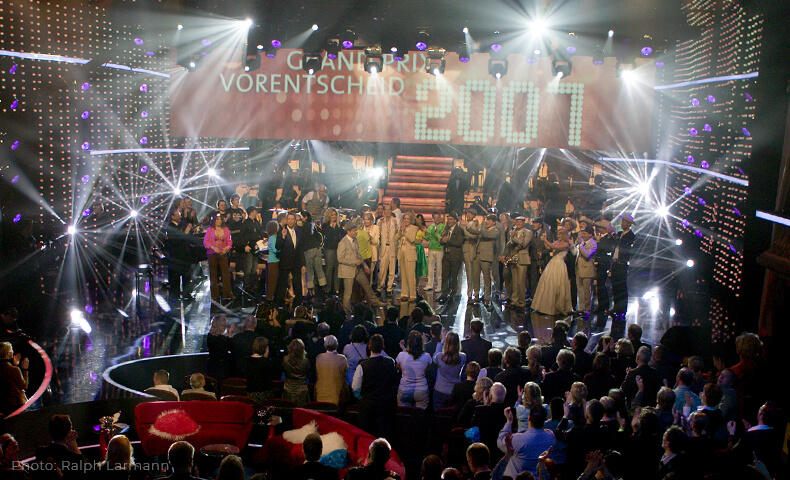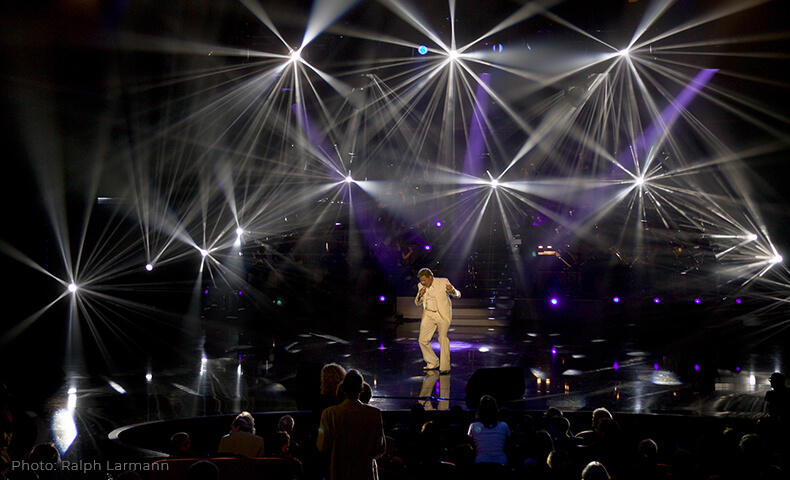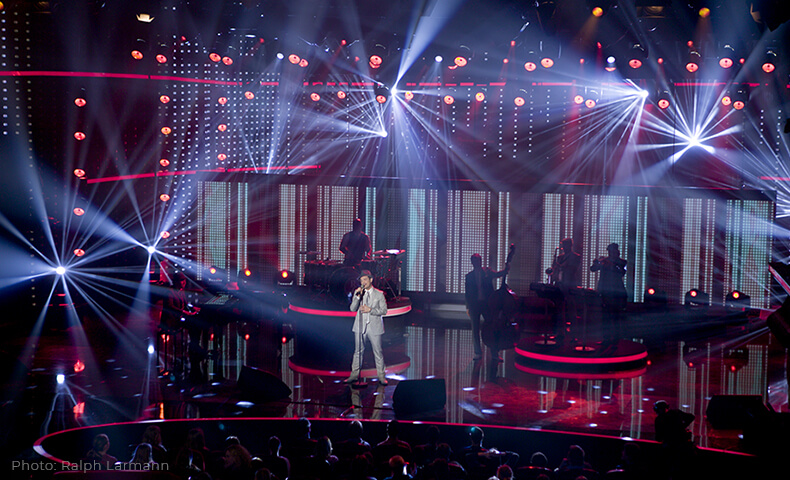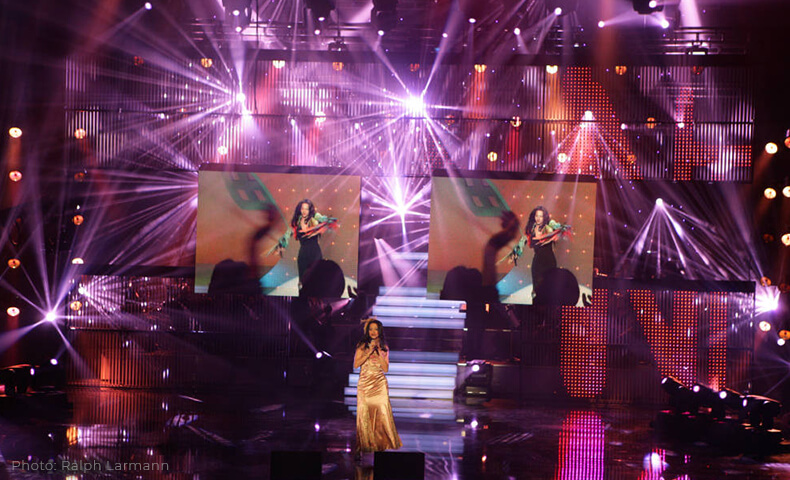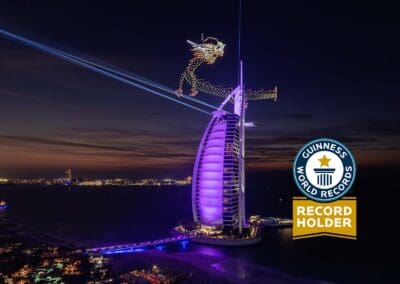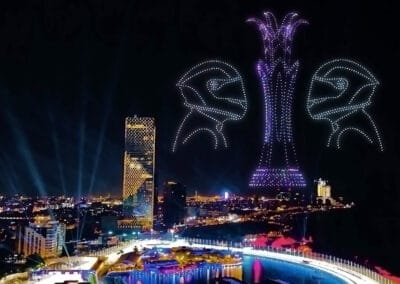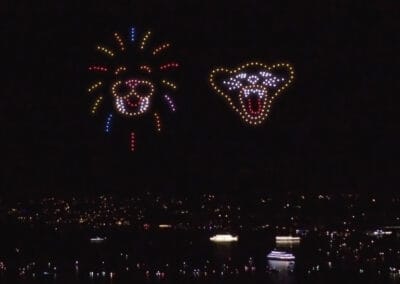Eurovision Song Contest
EuropeThe lighting designers Frederik Jönsson, Emma Landare and Johan Moritz employ FALCONs at Eurovision Song Contest in Malmö
May 2013, Malmö, Sweden – On May 18th, 2013, the final of the 58th Eurovision Song Contest took place and A&O Technology was on board again as a supplier for the biggest international live music contest.
Together with a multitude of FALCON FLOWER and FALCON BEAM 7,000 watts and 3,000 watts xenon floodlights and by the order of the Production Resource Group (PRG) A&O Technology was on location in Malmö where the great final show was going to start. The lighting designers Fredrik Jönsson (LD) and Emma Landare (Associate LD) used the FALCON fixtures for the very special highlights.
In addition to the indoor arena several outdoor locations were spectacularly stage-managed by using the light of the FALCON floodlights. By the order of the Swedish company United Audio Starlight AB (Starlight) A&O Technology delivered FALCONs for the outdoor locations. Live Site designer and City of Malmö lighting designer Johan Moritz bestowed the city with Eurovision spirit, including the twisted 190 metres tall building Turning Torso.
It was an exciting and impressive song contest which was broadcasted live on TV and also as live stream on eurovision.de! Prior to the grand final on Saturday evening, on May 14th and 16th the half finals had run.
Crystal Hall in Baku illuminated by FALCON searchlights
With the urgency implicit in the title of its own entry, “Running Scared”, Azerbaijan had within the space of a few months erected an arena of exceptional architectural merit in which to stage on its own territory the Eurovision Song Contest. And to ensure a light show every bit as magnificent, the crew that had handled last year’s final in Düsseldorf was retained: Cape Cross Studio + Filmlicht GmbH as general technical contractor along with lighting designer Jerry Appelt. Also present were a host of FALCON luminaires from A&O Technology. Their task was to ensure not only that the performers on stage shone but also that the venue itself was seen to best advantage, through an artistically choreographed light show. When all the votes were in, the result was incontrovertible: Loreen, with her song “Euphoria”, won by a landslide, ensuring that the venue for the next Eurovision Song Contest, in 2013, will be Stockholm. In fact, the 372 points garnered by the Swedish singer gave her the second highest score in the history of the ESC
This year’s Eurovision Song Contest in Baku, Azerbaijan, generated a great deal of publicity. Not all of it devoted to the subject of immediate relevance: music. Nothing, however, could detract from the splendour of the event itself. Despite a great deal of heated discussion, the contest went ahead in the ‘Land of Fire’, Azerbaijan, and the high expectations for the show were not only met but exceeded, for the lighting design devised by the German lighting designer Jerry Appelt embraced not only the interior of the Crystal Hall in Baku with its integrated Green Room but at the same time cast the entire 25-metre-high arena in the most flattering light. Alongside, the world’s highest flagpole in the nearby National Flag Square was virtually dwarfed. For the multifarious lighting images he created, Jerry Appelt specified inter alia FALCON FLOWER colour 7.000W and FALCON BEAM colour 7.000W luminaires from A&O Technology.
Cape Cross Studio + Filmlicht GmbH, the general technical contractor, had had some seventy FALCON luminaires transported from Germany to the capital of Azerbaijan to provide the two semi-final shows as well as the grand final with their optical highlights. The FALCON FLOWER luminaires were deployed inside the auditorium, where they were installed both above and below the stage, producing magical scenic effects, the impact of titles like Donny Montells “Love is Blind“ (Lithuania) and Loreen’s “Euphoria“ (Sweden) being dramatically enhanced by the raiment of filigree threads and sequins woven and scattered by the lights.
Roman Lob (winner of the German casting show “Unser Star für Baku“), representing Germany with the song “Standing Still“, finished in eighth place; but his performance could hardly compete with the mystical, near-solo performance by the ‘wood nymph’ Loreen, whose song “Euphoria”, with its David Guetta-like sounds, struck a chord with viewers throughout Europe. Perhaps the lighting design, which bordered on minimalism but was scarcely the less poignant for that, contributed to this triumph. Her unusual performance was thrown into relief by the play of light and shadow. Seldom can the distinct and filigree beams of the FALCON FLOWER have been used to such magical and impressive effect. Jerry Appelt certainly knows his craft inside out, as well as being exceptionally well versed in the devices of the FALCON range.
This was already evident from outside the building, for the spectacular light show was by no means confined to the interior. The stage provided by the unique location on the shore of the Caspian Sea was also illuminated and rendered visible for miles around. The Baku skyline was the richer on the three evenings the competition lasted for an illumination at once vibrant and informative, as the diamond-like facade of the Crystal Hall, studded with lighting elements, was bathed in the national colours of whichever country’s performers were at that moment on stage. In addition, the hall, which is over 200 metres long and 160 metres wide, was ringed by FALCON BEAM xenon searchlights, for which an elaborate choreography had been programmed in which the beams opened, closed, flickered and created impressive patterns.
So in the end Baku showed that despite all the controversial coverage, in musical and technical terms, when it came to putting on a show, it was a worthy setting for the Eurovision Song Contest. Anke Engelke, the president of the German jury, who was charged with announcing live the destination of the German votes, took advantage of the chance this afforded to direct some carefully chosen words at Azerbaijan’s authoritarian regime. “Tonight nobody could vote for their own country. But it is good to be able to vote. And it is good to have a choice. Good luck on your journey, Azerbaijan. Europe is watching you!”
The Eurovision Song Contest is the world’s largest live music competition. The official production partner of the ESC 2012 was Brainpool TV GmbH. In 2012, forty-two countries participated in the contest, the motto of which was “Light your fire”. Completed in April, the Crystal Hall in Baku accommodated some 16,000 spectators. According to Eurovision.de, the live transmission from Baku on German television’s Das Erste (ARD Channel One) drew an average of 8.29 million viewers.
AO Technology FALCONS shine on Eurovision in Düsseldorf
The FALCON® FLOWER made quite an impression at the 56th Eurovision Song Contest recently held at Düsseldorf Arena in Germany. The show is known for making technical leaps and bounds and this year marked the biggest Eurovision in history with regards to lighting equipment and live audience. Germany had not hosted the show since 1983 but when Lena Meyer-Landrut won Eurovision 2010 in Norway with her song “Satellite”, Germany was determined to show the world how a show should be done…big.
The show’s name says it all. It’s a song contest between member countries of the European Broadcasting Union (EBU). The public votes for their favourite song and the winner hosts the contest the following year. 43 countries competed this year, tying for the most since Serbia 2008. Three live broadcasts were held – two Semi-finals on May 10th and 12th and the Finals on May 14th in front of the largest live viewing audience in Eurovision history with 36,000. Another 200 million estimated television and internet viewers make Eurovision the largest music television program in the world.
Internationally known German Lighting Designer Jerry Appelt specified masses of lighting to deliver unique looks for the 43 countries, three interval acts and opening act for the Final broadcast. Over 2,100 moving lights were incorporated into the design, with the majority hung overhead, spanning the entire space of Düsseldorf Arena. Clearly, this needed a powerful balance from the floor.
24 FALCON FLOWER 3000W made a massive impact at floor level with 4 placed on each side of the stage at its widest position and another 12 lined along the back LED stage wall. 4 more were placed on the catwalks in front of the stage.16 FALCON FLOWER 7000W were placed in the ceiling, with 8 hung on moving truss directly behind the stage. Lighting control was delivered via grandMA2 full-size consoles, triggered via timecode.
The FALCON FLOWER is a unique xenon multi-beam effect-light with colour changer, pan-and-tilt movement, electronic and mechanical dimmer, douser, electronic strobe and integrated electronic power supply. An infinitely variable, rotating reflector produces up to 30 individual beams. The fixture delivered an exciting punch to many of the songs on Eurovision with multibeam effects in the shape of stars or flowers or just a simple yet powerful beam.
Concert and Stage Producer Ola Melzig, who has worked on nine Eurovision productions, worked closely with the delegations and artists regarding the details of each performance including lighting, video, pyro, sound and camera angles. “The FALCONs ROCK – there was no doubt when those things were fired, the effects were awesome. Jerry used them for very special looks and I can tell you, those countries were thrilled.”
Appelt said of the FALCON: “I use the 3K all the time. It’s very powerful and when I need that look, it’s the only one I go to. Düsseldorf Arena is huge and I wanted beams to reach to every corner. This was actually the first time I used the 7K and the results were fantastic. Really great light and nice beam effects – I’ll definitely use them again.”
Cape Cross of Cologne, Germany provided all lighting and rigging for the show, sending 130 trucks, each with 40 tonnes of equipment. Thomas Brügge, Managing Director of Cape Cross said, “We use FALCONs in almost every show we do – they’re incredibly strong. Not many lights can do what they do. The Xenon is a very special form of light. I’ve seen many companies try to copy it but none have succeeded like the FALCON. It’s really brilliant.”
The company behind the creative production of Eurovision 2011 was Brainpool TV GmbH, led by Producer Jörg Grabosch. Brainpool managed all creative aspects including staging, lighting, pyro, hosts, viewing room, technical crew, etc. and managed the companies in charge of these areas: Cape Cross (lighting & rigging); Creative Technology (video); Stage Kinetic (moving LED screen); MCI (set construction); and LunatX (pyro).
In the end, Azerbaijan was crowned winner with the song “Running Scared”, earning 221 points. Eurovision 2012 will be held in Baku, Azerbaijan.
Eurovision Design Team:
Lighting Design: Jerry Appelt
Stage Design: Florian Wieder
FOH: Matthias Rau, Matthias Hagel, Wolfgang Nöhrer, Sascha Matthes, Michael Giegerich, Markus Ruhnke, “Matze” Meyert
Host broadcaster: NDR
Executive Producer: Thomas Schreiber
Executive Supervisor of EBU: Jon-Ola Sand
Text: Joan Lyman for A&O Technology
NDR Grand Prix Gala
LOCATION: Deutsches Schauspielhaus Hamburg, Germany
DATE: 2005, 2006, 2007, 2008
AO EQUIPMENT: FALCON BEAM colour 3kW, FALCON FLOWER 3kW
LIGHTING DESIGN: Andreas Paeper, 1. Kameramann des NDR in Kooperation mit A&O Creative (Video content, Preprogramming)
SUPPORT: A&O Lighting Technology Germany
PHOTOS: A&O Technology, Ralph Larmann (2006)
LOCATION/DATE:
May 2013 – Malmö, Sweden
May 2012 – Crystal Hall Baku, Azerbaijan
May 2011 – Esprit Arena Düsseldorf, Germany
AO EQUIPMENT:
FALCON BEAM colour 7,000W
FALCON BEAM colour 3,000W
FALCON FLOWER colour 3,000W
FALCON FLOWER colour 7,000W
LIGHTING DESIGN:
Malmö: Fredrik Jönsson, Emma Landare, Johan Moritz
Baku: Jerry P. Appelt, General Technical Instructor: Cape Cross Studio + Filmlicht GmbH
Düsseldorf: Jerry P. Appelt, support: AO Technology (FALCON FLOWER)
PHOTOS:
Ralph Larmann, Joan Lyman Melzig, Joakim Raboff, AO Technology







